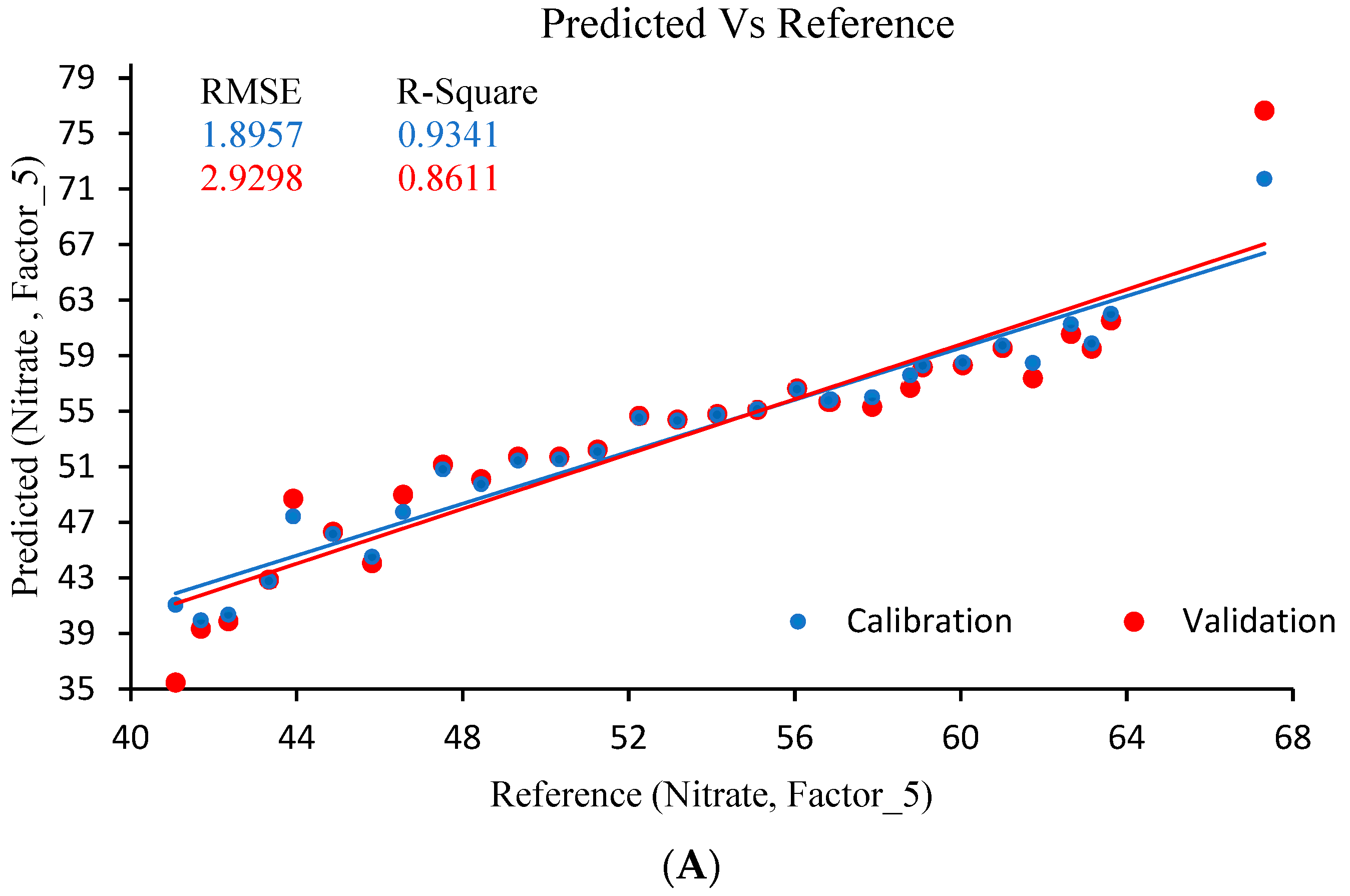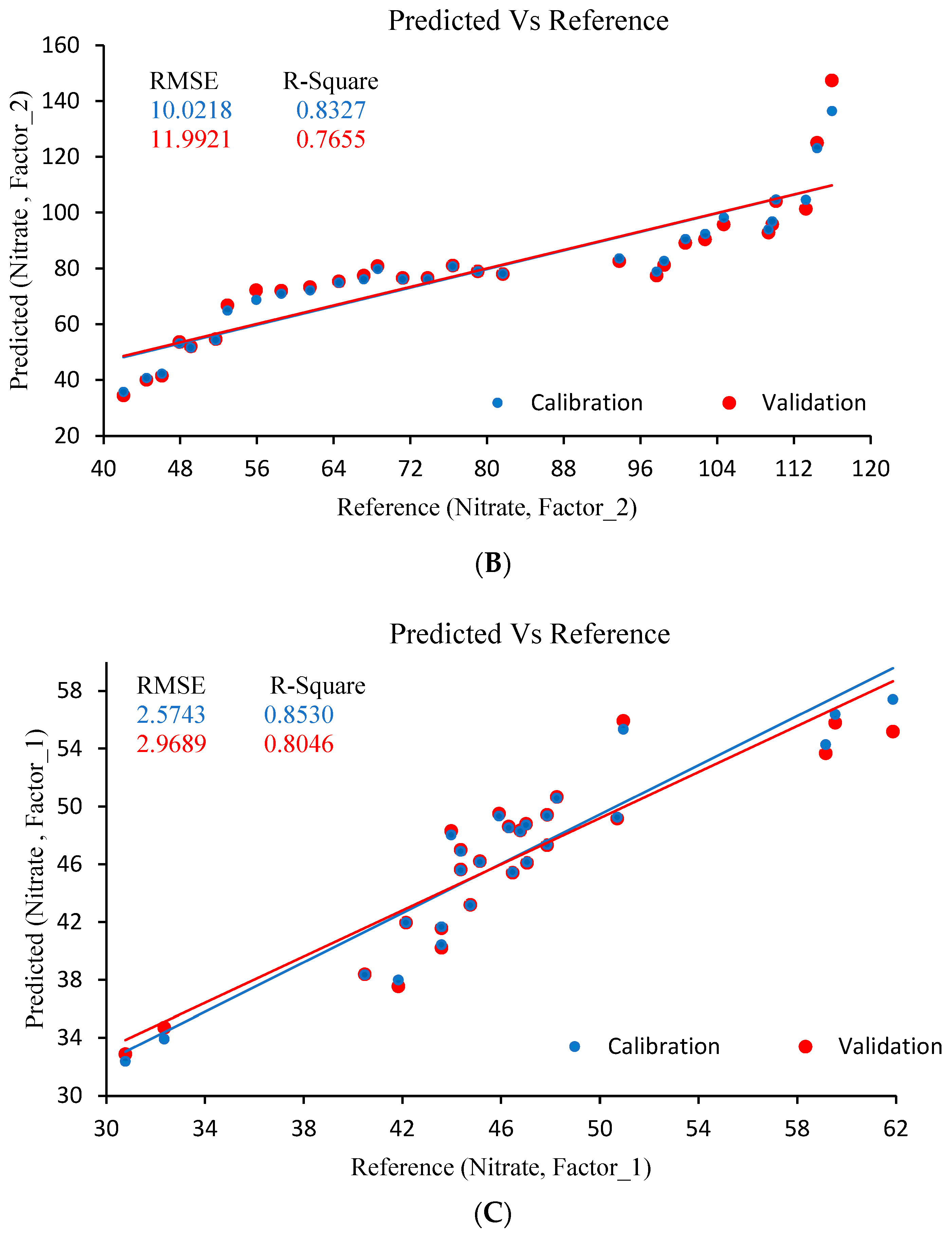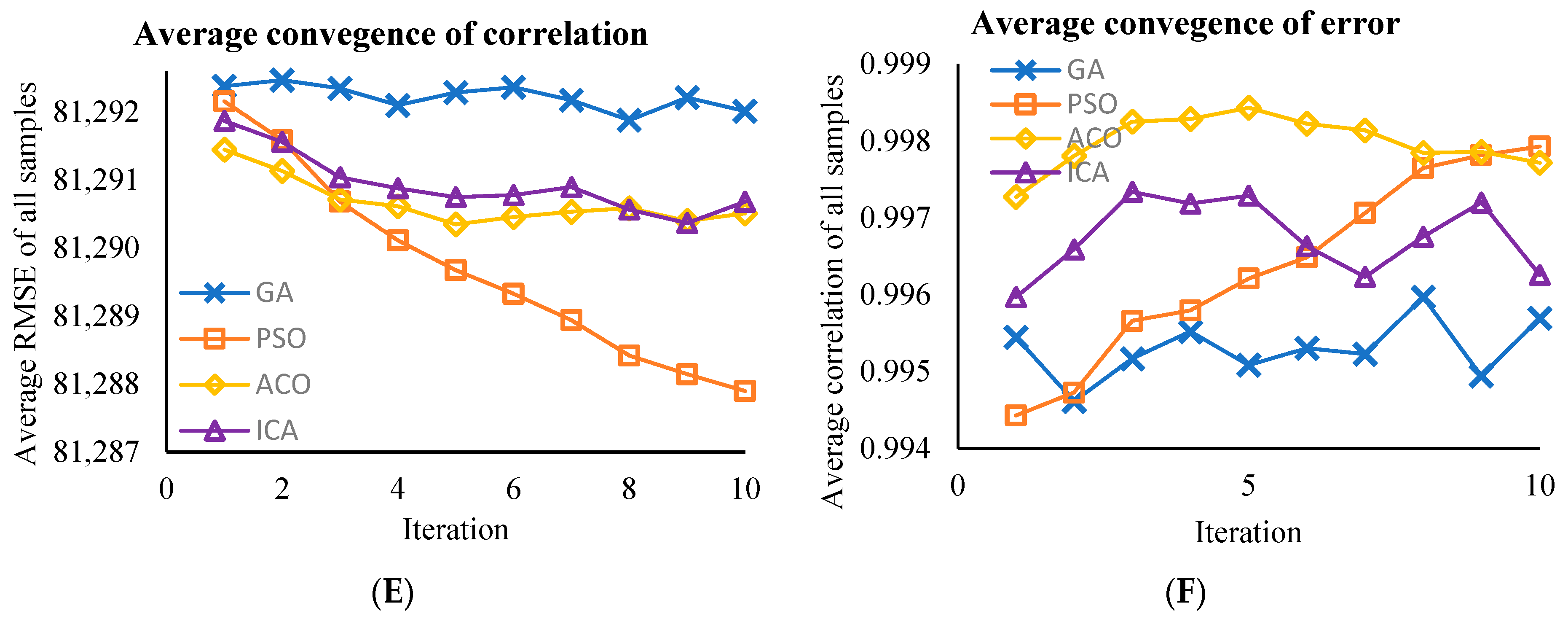Analyzing the Nitrate Content in Various Bell Pepper Varieties Through Non-Destructive Methods Using Vis/NIR Spectroscopy Enhanced by Metaheuristic Algorithms
Abstract
1. Introduction
2. Materials and Methods
2.1. Sample Preparation
2.2. Vis/NIR Spectroscopy
2.3. Nitrate Evaluations
2.4. Data Analysis
2.4.1. PLSR and Finding the Effective Wavelength
2.4.2. Modeling by Effective Wavelengths
3. Results and Discussion
3.1. Partial Least Squares Regression (PLSR)
3.2. Effective Wavelengths
3.3. Model Development Using Representative Wavelengths
4. Conclusions
Author Contributions
Funding
Data Availability Statement
Conflicts of Interest
References
- Lahbib, K.; Dabbou, S.; Bok, S.E.; Pandino, G.; Lombardo, S.; Gazzah, M.E. Variation of biochemical and antioxidant activity with respect to the part of Capsicum annuum fruit from Tunisian autochthonous cultivars. Ind. Crops Prod. 2017, 104, 164–170. [Google Scholar] [CrossRef]
- Rawat, S.; Pullagurala, V.L.; Hernandez-Molina, M.; Sun, Y.; Niu, G.; Hernandez-Viezcas, J.A.; Peralta-Videa, J.R.; Gardea-Torresdey, J.L. Impacts of copper oxide nanoparticles on bell pepper (Capsicum annum L.) plants: A full life cycle study. Environ. Sci. Nano 2018, 5, 83–95. [Google Scholar] [CrossRef]
- Sarker, M.; Hasan, S.; Aziz, M.; Islam, M.; Azam, S.; Roy, S.; Ibrahim, M. The Effect of Processing Treatments on the Shelf Life and Nutritional Quality of Green Chilli (Capsicum annuum L.) Powder. Pertanika J. Trop. Agric. Sci. 2012, 35, 855–864. [Google Scholar]
- Colla, G.; Kim, H.-J.; Kyriacou, M.C.; Rouphael, Y. Nitrate in fruits and vegetables. Sci. Hortic. 2018, 237, 221–238. [Google Scholar] [CrossRef]
- Njeze, G.; Dilibe, U.; Ilo, C. Nitrate and drinking water from private wells: Will there be an epidemic of cancers of the digestive tract, urinary bladder and thyroid? Niger. J. Clin. Pract. 2014, 17, 178–182. [Google Scholar] [CrossRef] [PubMed]
- Martin, K.R. Dietary nitrates, nitrites, and food safety: Risks versus benefits. Acta Sci. Nutr. Health 2021, 5, 65–76. [Google Scholar] [CrossRef]
- Levallois, P.; Phaneuf, D. Contamination of drinking water by nitrates: Analysis of health risks. Can. J. Public Health Rev. Can. De Sante Publique 1994, 85, 192–196. [Google Scholar]
- Liang, X.; Gao, Y.; Zhang, X.; Tian, Y.; Zhang, Z.; Gao, L. Effect of optimal daily fertigation on migration of water and salt in soil, root growth and fruit yield of cucumber (Cucumis sativus L.) in solar-greenhouse. PLoS ONE 2014, 9, e86975. [Google Scholar] [CrossRef]
- Tabande, L.; Zarei, M. Overview of Nitrate Concentration in Some Vegetables Produced in Zanjan Province. Iran. J. Soil Res. 2018, 32, 373–381. [Google Scholar]
- Fodor, M.; Matkovits, A.; Benes, E.L.; Jókai, Z. The Role of Near-Infrared Spectroscopy in Food Quality Assurance: A Review of the Past Two Decades. Foods 2024, 13, 3501. [Google Scholar] [CrossRef]
- Jamshidi, B.; Yazdanfar, N. Development of a spectroscopic approach for non-destructive and rapid screening of cucumbers based on maximum limit of nitrate accumulation. J. Food Compos. Anal. 2022, 110, 104513. [Google Scholar] [CrossRef]
- Srivichien, S.; Terdwongworakul, A.; Teerachaichayut, S. Quantitative prediction of nitrate level in intact pineapple using Vis–NIRS. J. Food Eng. 2015, 150, 29–34. [Google Scholar] [CrossRef]
- Ito, H.; Horie, H.; Ippoushi, K.; Azuma, K. Potential of Visible-Near Infrared (VIS-NIR) Spectroscopy for Non-destructive Estimation of Nitrate Content Oin Japanese Radishes. In Proceedings of the International Conference on Quality in Chains. An Integrated View on Fruit and Vegetable Quality 604, Wageningen, The Netherlands, 6 July 2003; pp. 549–552. [Google Scholar]
- Mahanti, N.K.; Chakraborty, S.K.; Kotwaliwale, N.; Vishwakarma, A.K. Chemometric strategies for nondestructive and rapid assessment of nitrate content in harvested spinach using Vis-NIR spectroscopy. J. Food Sci. 2020, 85, 3653–3662. [Google Scholar] [CrossRef] [PubMed]
- Vega-Castellote, M.; Pérez-Marín, D.; Torres, I.; Sánchez, M.-T. Online NIRS analysis for the routine assessment of the nitrate content in spinach plants in the processing industry using linear and non-linear methods. LWT 2021, 151, 112192. [Google Scholar] [CrossRef]
- Kim, S.-Y.; Hong, S.-J.; Kim, E.; Lee, C.-H.; Kim, G. Application of ensemble neural-network method to integrated sugar content prediction model for citrus fruit using Vis/NIR spectroscopy. J. Food Eng. 2023, 338, 111254. [Google Scholar] [CrossRef]
- Ruggiero, L.; Amalfitano, C.; Di Vaio, C.; Adamo, P. Use of near-infrared spectroscopy combined with chemometrics for authentication and traceability of intact lemon fruits. Food Chem. 2022, 375, 131822. [Google Scholar] [CrossRef]
- Liu, S.; Huang, W.; Lin, L.; Fan, S. Effects of orientations and regions on performance of online soluble solids content prediction models based on near-infrared spectroscopy for peaches. Foods 2022, 11, 1502. [Google Scholar] [CrossRef]
- Kasampalis, D.S.; Tsouvaltzis, P.; Ntouros, K.; Gertsis, A.; Gitas, I.; Siomos, A.S. The use of digital imaging, chlorophyll fluorescence and Vis/NIR spectroscopy in assessing the ripening stage and freshness status of bell pepper fruit. Comput. Electron. Agric. 2021, 187, 106265. [Google Scholar] [CrossRef]
- Latifi Amoghin, M.; Abbaspour-Gilandeh, Y.; Tahmasebi, M.; Kaveh, M.; El-Mesery, H.S.; Szymanek, M.; Sprawka, M. VIS/NIR Spectroscopy as a Non-Destructive Method for Evaluation of Quality Parameters of Three Bell Pepper Varieties Based on Soft Computing Methods. Appl. Sci. 2024, 14, 10855. [Google Scholar] [CrossRef]
- Cataldo, D.; Maroon, M.; Schrader, L.E.; Youngs, V.L. Rapid colorimetric determination of nitrate in plant tissue by nitration of salicylic acid. Commun. Soil Sci. Plant Anal. 1975, 6, 71–80. [Google Scholar] [CrossRef]
- Masoudi-Sobhanzadeh, Y.; Motieghader, H.; Masoudi-Nejad, A. FeatureSelect: A software for feature selection based on machine learning approaches. BMC Bioinform. 2019, 20, 170. [Google Scholar] [CrossRef] [PubMed]
- McCall, J. Genetic algorithms for modelling and optimisation. J. Comput. Appl. Math. 2005, 184, 205–222. [Google Scholar] [CrossRef]
- Marini, F.; Walczak, B. Particle swarm optimization (PSO). A tutorial. Chemom. Intell. Lab. Syst. 2015, 149, 153–165. [Google Scholar] [CrossRef]
- Dorigo, M.; Bonabeau, E.; Theraulaz, G. Ant algorithms and stigmergy. Future Gener. Comput. Syst. 2000, 16, 851–871. [Google Scholar] [CrossRef]
- Atashpaz-Gargari, E.; Lucas, C. Imperialist competitive algorithm: An algorithm for optimization inspired by imperialistic competition. In Proceedings of the 2007 IEEE Congress on Evolutionary Computation, Singapore, 25–28 September 2007; pp. 4661–4667. [Google Scholar]
- Tahmasebi, M.; Tabatabaei-kolor, R. Measuring of Paddy mass flow using capacitive sensor and modeling with using multiple regression, ANN, and ANFIS models. Iran. J. Biosyst. Eng. 2017, 48, 221–227. [Google Scholar]
- Amoghin, M.L.; Abbaspour-Gilandeh, Y.; Tahmasebi, M.; Arribas, J.I. Automatic non-destructive estimation of polyphenol oxidase and peroxidase enzyme activity levels in three bell pepper varieties by Vis/NIR spectroscopy imaging data based on machine learning methods. Chemom. Intell. Lab. Syst. 2024, 250, 105137. [Google Scholar] [CrossRef]
- Amer Zamrik, M. Determination of nitrate and nitrite contents in pepper (capsicum) and their derived products in Syrian market. Int. J. Pharm. Sci. Rev. Res. 2013, 19, 16–20. [Google Scholar]
- Terbe, I.; Szabó, Z.; Kappel, N. Macronutrient accumulation in green pepper (Capsicum annuum L.) as affected by different production technologies. Int. J. Hortic. Sci. 2006, 12, 13–19. [Google Scholar] [CrossRef]
- Rahmia, D.; Pratiwi, E.; Pahlawan, M.; Amanah, H.; Masithoh, R. Non-destructive measurement of malic acid content of sapodilla fruit using visible near infrared (VisNIR) spectroscopy with variations in storage temperature. In Proceedings of the IOP Conference Series: Earth and Environmental Science, Banda Aceh, Indonesia, 9–10 August 2022; p. 012027. [Google Scholar]
- Hu, L.; Yin, C.; Ma, S.; Liu, Z. Vis-NIR spectroscopy combined with wavelengths selection by PSO optimization algorithm for simultaneous determination of four quality parameters and classification of soy sauce. Food Anal. Methods 2019, 12, 633–643. [Google Scholar] [CrossRef]
- Zhang, H.; Gu, B.; Mu, J.; Ruan, P.; Li, D. Wheat hardness prediction research based on NIR hyperspectral analysis combined with ant colony optimization algorithm. Procedia Eng. 2017, 174, 648–656. [Google Scholar] [CrossRef]
- Jiang, Q.; Zhang, M.; Mujumdar, A.S.; Wang, D. Non-destructive quality determination of frozen food using NIR spectroscopy-based machine learning and predictive modelling. J. Food Eng. 2023, 343, 111374. [Google Scholar] [CrossRef]
- Lapcharoensuk, R.; Fhaykamta, C.; Anurak, W.; Chadwut, W.; Sitorus, A. Nondestructive detection of pesticide residue (Chlorpyrifos) on bok choi (Brassica rapa subsp. Chinensis) using a portable NIR spectrometer coupled with a machine learning approach. Foods 2023, 12, 955. [Google Scholar] [CrossRef] [PubMed]
- Taghinezhad, E.; Szumny, A.; Figiel, A.; Amoghin, M.L.; Mirzazadeh, A.; Blasco, J.; Mazurek, S.; Castillo-Gironés, S. The Potential Application of HSI and VIS/NIR Spectroscopy for Non-Invasive Detection of Starch Gelatinization and Head Rice Yield during Parboiling and Drying Process. J. Food Compos. Anal. 2025, 142, 107443. [Google Scholar] [CrossRef]




| Variable | Mean | StDev | Minimum | Maximum |
|---|---|---|---|---|
| Red | 53.20 | 7.51 | 41.08 | 67.31 |
| Yellow | 78.77 | 24.92 | 42.07 | 115.95 |
| Orange | 45.98 | 7.53 | 27.63 | 61.87 |
| Parameter | Spectral Range (nm) | Methods | No. | Selected EWs (nm) |
|---|---|---|---|---|
| Red | 580–980 | GA | 13 | 743, 683.5, 684.5, 967, 945.5, 980, 965, 861, 948, 904, 868.5, 957, 974.5 |
| PSO | 15 | 974, 970, 980.5, 960, 977, 975, 613.5, 970.5, 886, 964, 965.5, 949, 843, 951, 967.5 | ||
| ACO | 14 | 817.5, 961, 704, 945, 967, 973.5, 929.5, 932.5, 977, 631, 955, 922.5, 974, 907.5 | ||
| ICA | 15 | 951.5, 958, 802.5, 801.5, 979, 705, 969.5, 734, 961, 653.5, 954.5, 979.5, 973, 956.5, 965 | ||
| Yellow | 525–1000 | GA | 15 | 922.5, 907, 570, 997.5, 995, 841, 999.5, 762, 996, 722, 854, 996.5, 717, 986.5, 636 |
| PSO | 15 | 981.5, 557.5, 951.5, 999.5, 995.5, 960.5, 998, 822.5, 990.5, 983.5, 549, 997.5, 996.5, 940, 992 | ||
| ACO | 15 | 603, 776, 901.5, 964, 993, 898.5, 997.5, 979, 995, 740, 750.5, 549, 957.5, 998, 999 | ||
| ICA | 15 | 797, 561.5, 763.5, 952.5, 974, 989.5, 996, 777.5, 996.5, 998, 1000, 978, 589.5, 967, 806 | ||
| Orange | 565–960 | GA | 15 | 578, 830.5, 827.5, 781.5, 609, 752.5, 617, 733.5, 813.5, 565.5, 737.5, 886.5, 565, 902.5, 946.5 |
| PSO | 14 | 750, 810, 799, 673.5, 565.5, 733.5, 836, 716.5, 860, 795, 708.5, 957.5, 565, 710.5 | ||
| ACO | 15 | 578, 954, 585, 713, 778.5, 718, 709.5, 627.5, 565.5, 790.5, 565, 670, 958.5, 614.5, 728.5 | ||
| ICA | 14 | 782, 697, 798, 730, 565.5, 572.5, 574, 706.5, 775.5, 776, 711.5, 601.5, 565, 592.5 |
| Variety | PLSR | MLR | ||||||
|---|---|---|---|---|---|---|---|---|
| Calibration | Validation | Calibration | Validation | |||||
| R2 | RMSE | R2 | RMSE | R2 | RMSE | R2 | RMSE | |
| Red | 0.9155 | 2.1458 | 0.8766 | 2.6818 | 0.9604 | 2.1477 | NA | 15.0105 |
| Yellow | 0.8101 | 10.6743 | 0.7952 | 11.4686 | 0.9287 | 9.5743 | 0.5102 | 17.4386 |
| Orange | 0.8142 | 3.1816 | 0.7528 | 3.8164 | 0.9289 | 3.025 | NA | 10.7465 |
| Variety | Training | Validation | Test | |||
|---|---|---|---|---|---|---|
| R2 | RMSE | R2 | RMSE | R2 | RMSE | |
| Red | 0.9982 | 0.2851 | 0.9714 | 1.5718 | 0.9924 | 0.8841 |
| Yellow | 0.9886 | 2.6790 | 0.9910 | 3.1725 | 0.9616 | 4.3529 |
| Orange | 0.8957 | 2.3709 | 0.9293 | 4.3723 | 0.9425 | 5.7650 |
Disclaimer/Publisher’s Note: The statements, opinions and data contained in all publications are solely those of the individual author(s) and contributor(s) and not of MDPI and/or the editor(s). MDPI and/or the editor(s) disclaim responsibility for any injury to people or property resulting from any ideas, methods, instructions or products referred to in the content. |
© 2025 by the authors. Licensee MDPI, Basel, Switzerland. This article is an open access article distributed under the terms and conditions of the Creative Commons Attribution (CC BY) license (https://creativecommons.org/licenses/by/4.0/).
Share and Cite
Latifi-Amoghin, M.; Abbaspour-Gilandeh, Y.; Tahmasebi, M.; Kisalaei, A.; Hernández-Hernández, J.L.; Hernández-Hernández, M.; Cruz-Gámez, E.D.L. Analyzing the Nitrate Content in Various Bell Pepper Varieties Through Non-Destructive Methods Using Vis/NIR Spectroscopy Enhanced by Metaheuristic Algorithms. Processes 2025, 13, 1731. https://doi.org/10.3390/pr13061731
Latifi-Amoghin M, Abbaspour-Gilandeh Y, Tahmasebi M, Kisalaei A, Hernández-Hernández JL, Hernández-Hernández M, Cruz-Gámez EDL. Analyzing the Nitrate Content in Various Bell Pepper Varieties Through Non-Destructive Methods Using Vis/NIR Spectroscopy Enhanced by Metaheuristic Algorithms. Processes. 2025; 13(6):1731. https://doi.org/10.3390/pr13061731
Chicago/Turabian StyleLatifi-Amoghin, Meysam, Yousef Abbaspour-Gilandeh, Mohammad Tahmasebi, Asma Kisalaei, José Luis Hernández-Hernández, Mario Hernández-Hernández, and Eduardo De La Cruz-Gámez. 2025. "Analyzing the Nitrate Content in Various Bell Pepper Varieties Through Non-Destructive Methods Using Vis/NIR Spectroscopy Enhanced by Metaheuristic Algorithms" Processes 13, no. 6: 1731. https://doi.org/10.3390/pr13061731
APA StyleLatifi-Amoghin, M., Abbaspour-Gilandeh, Y., Tahmasebi, M., Kisalaei, A., Hernández-Hernández, J. L., Hernández-Hernández, M., & Cruz-Gámez, E. D. L. (2025). Analyzing the Nitrate Content in Various Bell Pepper Varieties Through Non-Destructive Methods Using Vis/NIR Spectroscopy Enhanced by Metaheuristic Algorithms. Processes, 13(6), 1731. https://doi.org/10.3390/pr13061731












